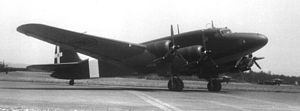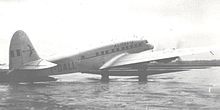Savoia-Marchetti SM.95 Video - Picture

|
|
Savoia-Marchetti SM.95

Picture - SM.95 NC.41001 with Regia Aeronautica insigna
Role: Civil airliner / military transport
Manufacturer: Savoia-Marchetti
First flight: 8 May 1943
Primary user: Regia Aeronautica
Produced: 1942-1949
Number built: 12
Developed from: Savoia-Marchetti SM.75
The Savoia-Marchetti SM.95 was an Italian four-engine, mid-range transport aircraft, which first flew in 1942. It was the successor of the Savoia-Marchetti SM.75.
Design and development
The SM.95 was announced in 1937, when the future was seen in the 4-engined aircraft. Until that time Italy has mainly used 3-engined aircraft. The SM.95, designed by Alessandro Marchetti, first flew on 8 May 1943. Originally named SM.76 it was fitted with four 750 hp A.R. 126 RC.34. In 1939 the project was renamed SM.95C (C for Civil), with the more powerful Alfa Romeo RC.18 (860 hp) engine.
With the start of World War II, this project was stopped until December 1941, when L.A.T.I. called for a 4-engined useful for South American routes. It had, nevertheless, inferior performances compared to P.108C and Z.511A, both metallic and more powerful. But the new SM.95 had lower costs and a swifter development.
The aircraft was similar to other contemporary airliners, but the construction was mixed. Welded steel was used for the fuselage structure, with light alloy covering fitted to the nose, underside and rear fuselage, and fabric covering for the fuselage sides and roof. The three-spar wing was also of wooden construction, with plywood skinning. The engines drove three-bladed metal Constant speed propellers.
The two pilots sat side-by-side in an enclosed cockpit, while behind them sat the Flight engineer (on the left) and radio operator (on the right). Behind the cockpit, there was normally seating for 20-30 passengers, with up to 38 being able to be carried over short ranges.
There was an initial need for a bomber version, SM.95B, with enhanced engines and a weapon set. Nevertheless, the first to fly was the SM.95C, on 3 August 1943, at (Vergiate), with Guglielmo Algarotti flying.
Operational history
The Armistice stopped the program, and the only two aircraft built at the time were requested by Germans and sent to Germany, then they flew with Luftwaffe and were subsequently lost.
On 28 July 1945, a third example flew, used with a fourth (still unfinished at the end of the war) with the Aeronautica Militare. One was taken by RAF. The service with A.M. started after April 1946. Alitalia bought six examples, in service since 1947. LATI bought 3 examples in 1949. Lastly, four SM.95s were bought by SAIDE. They were used in a Cairo-Rome-Paris route. The only military costumer was AMI, that had five of them.
SM.95C was a development model. The first were produced with AR.128 RC.18, the third with A.R. 131 RC.14/50, the next examples had Bristol Pegasus 48 (1,005 hp), and LATI used even more powerful Twin Wasp R-1830 (1,217 hp). A final development, the SM.95S with a metal structure was planned but not built.
The last SM.95 was completed on 18 November 1949, the last of 20 officially built. They had not exceptional performance, even with PW engines, and had no pressurization at all, therefore they could not fly very high. The mixed construction did not last too long: the last flight was on 28 September 1954 (1950 with Alitalia).
Operation "S"

Picture - Alitalia SM.95 on scheduled service at Manchester in April 1948
The interest for a military use was confirmed with a very daring mission: the bombing of New York. In July 1939, the S.M.75 obtained a record of 12,935 km (8,034 mi), there were several long-range missions both with S.M.82 and the S.M.75, while for S operation it was considered the 4-engined CANT Z.511, an all-metal floatplane. It had, however, some shortcomings: basically it needed to be refuelled by a submarine in the middle of the ocean. Although it was able to operate in adverse sea conditions (up to 5-force gales), this was not a very good idea, especially in the last year of war. It was proposed that a long-range version of this aircraft, the SM.95 GA (with a range of over 11,000 km/6,840 mi) could be used to mount a bombing raid on New York City launched from Western France, but the presence of many Italian-Americans in the city meant that Benito Mussolini would only authorize the dropping of propaganda pamphlets. It was reported that the fuel load was raised to 23,800 kg, for a total of 39,3 tons. The mission, with a 500 kg (1,100 lb) load, was still in preparation when Italy signed the Armistice in September 1943.
Operators
Civil operators
Italy
LATI (Linee Aeree Transcontinentali Italiane)
Italy - Postwar
Alitalia
Egypt - Postwar
SAIDE
Military operators
Italy
Regia Aeronautica
Italy - Postwar
Aeronautica Militare
Specifications (SM.95)
Data from World Encyclopedia of Civil Aircraft
General characteristics
Crew: 4-5
Capacity: 20-38 passengers
Length: 24.77 m (81 ft 3 in)
Wingspan: 34.28 m (112 ft 5¾ in)
Height: 5.25 m (17 ft 2½ in)
Wing area: 128.3 m² (1,381 ft²)
Empty weight: 13,310 kg (29,282 lb)
Loaded weight: 21,655 kg (47,641 lb)
Powerplant: 4x— Alfa Romeo 128 RC.18 radial engines, 634 kW (850 hp) each
Performance
Maximum speed: 361 km/h (195 kn, 224 mph)
Cruise speed: 315 km/h (170 knots, 196 mph)
Range: 2,000 km (1,080 nmi, 1,240 mi)
Service ceiling: 6,350 m (20,830 ft)
Bibliography
Angelucci, Enzi. World Encyclopedia of Civil Aircraft. London: Willow Books, 1984. ISBN 0-00-218148-7.
Stroud, John. "Post War Propliners, Part 3: S.M.95." Aeroplane Monthly, August 1992, Vol. 20, No 8, Issue No 232, pp. 64-68. London: IPC. ISSN 0143-7240.
Savoia-Marchetti SM.95 Pictures
More airplane videos.
Source: WikiPedia